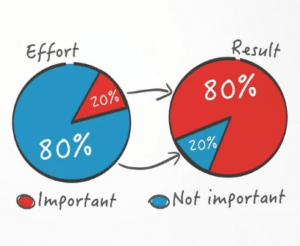The Pareto principle states that for many outcomes roughly 80% of consequences come from 20% of the causes.
Why you need to identify the vital few from the trivial many.
You just got the promotion! Congratulations!
As you step into your new assignment, you discover you’ve inherited a whole host of problems that need your attention—and now! How do you decide which problems you need to deal with first?
Il principio di Pareto.
 You don’t have to look at the leading edge of management strategy and tools to find an answer. In fact, it will help if you go back in time to Italy a little more than a century ago. It was there that Vilfredo Federico Damaso Pareto, a civil engineer and economist made the observation that 80% of the land wealth was controlled by 20% of the population. Soon he discovered that the 80/20 rule could help to understand many circumstances. He wrote, “For many events, roughly 80% of the effects come from 20% of the causes.”
You don’t have to look at the leading edge of management strategy and tools to find an answer. In fact, it will help if you go back in time to Italy a little more than a century ago. It was there that Vilfredo Federico Damaso Pareto, a civil engineer and economist made the observation that 80% of the land wealth was controlled by 20% of the population. Soon he discovered that the 80/20 rule could help to understand many circumstances. He wrote, “For many events, roughly 80% of the effects come from 20% of the causes.”
Prioritize different problems or tasks by comparing the benefit that solving each one will provide.
This simple observation—called the Pareto Principle, or 80/20 rule—is extremely helpful in bringing quick and easy clarity to complex situations and problems (such as your new job assignment)—especially when deciding where to focus effort and resources.
The Pareto Principle (at a simple level) suggests that where two related data sets or groups exist (typically cause and effect, or input and output), they often show certain behavior. For example:
- 80% of the downtime come from 20 percent of problems.
- 80% of a company’s profits come from 20% of its customers.
 In other words, 80% of your sales, will come from 20% of your customers. Or 80% of your overall costs will come from 20% of what you buy. 80% of your time online will come from just 20% of the actions you take online. 80% of new customers will come from 20% of your advertising effort.
In other words, 80% of your sales, will come from 20% of your customers. Or 80% of your overall costs will come from 20% of what you buy. 80% of your time online will come from just 20% of the actions you take online. 80% of new customers will come from 20% of your advertising effort.
The goal of the Pareto approach in problem-solving is to find where we should be focusing our efforts. As a Lean management tool, the Pareto Principle suggests that you focus on the most frequent and serious causes of poor quality and waste—and fix them first.
Richard Koch, author of The 80/20 Principle: The Secret to Achieving More with Less, wrote,
“80 percent of products, or customers or employees, are only contributing 20 percent of profits; in that there is great waste. The most powerful resources of the company are being held back by a majority of much less effective resources. In this kind of situation, one might well ask: why continue to make the 80 percent of products that only generate 20 percent of profits? Companies rarely ask these questions, perhaps because to answer them would mean very radical action: to stop doing four-fifths of what you are doing is not a trivial change.”
Progress is all about using energy, where seemingly small efforts can go a long way. The Pareto Principle always tells us where the bang for the buck is greatest. Work on the tasks that take up 20% effort or time, but will give you 80% of the results.
KPI Fire’s Pareto feature is a powerful tool for identifying the most significant contributors to a problem or issue. Based on the Pareto principle, which states that 80% of consequences come from 20% of the causes, the Pareto feature allows you to visualize and analyze data to identify the most impactful factors.
Here’s how the Pareto feature works in KPI Fire:
- Create a Pareto chart: Select the data you want to analyze and create a Pareto chart.
- Identify the most significant factors: The chart will visually represent the frequency of occurrence of different factors, allowing you to easily identify the most significant contributors.
- Prioritize your efforts: Focus your improvement efforts on the factors that have the greatest impact.
By using the Pareto feature in KPI Fire, you can:
- Identify root causes: Determine the underlying causes of problems or issues.
- Prioritize improvement efforts: Focus on the most impactful areas for maximum results.
- Optimize resource allocation: Allocate resources to the areas that will have the greatest impact.
- Drive continuous improvement: Use the Pareto principle to guide your improvement initiatives and achieve long-term success.



